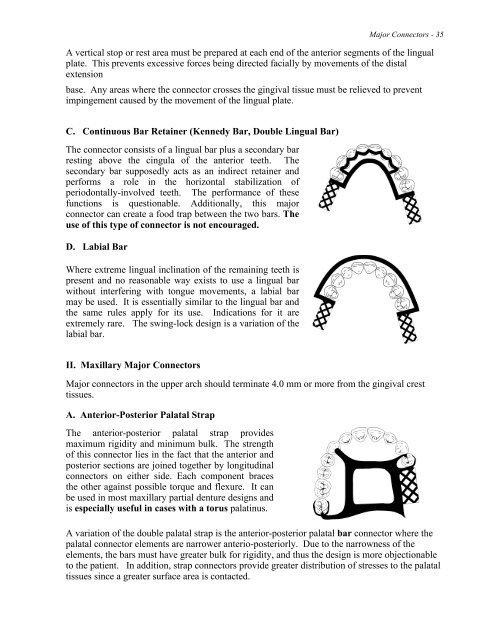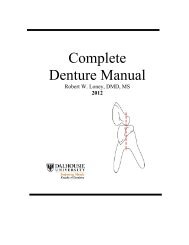RPD Manual 11 - Removable Prosthodontics - Dalhousie University
RPD Manual 11 - Removable Prosthodontics - Dalhousie University
RPD Manual 11 - Removable Prosthodontics - Dalhousie University
Create successful ePaper yourself
Turn your PDF publications into a flip-book with our unique Google optimized e-Paper software.
Major Connectors - 35<br />
A vertical stop or rest area must be prepared at each end of the anterior segments of the lingual<br />
plate. This prevents excessive forces being directed facially by movements of the distal<br />
extension<br />
base. Any areas where the connector crosses the gingival tissue must be relieved to prevent<br />
impingement caused by the movement of the lingual plate.<br />
C. Continuous Bar Retainer (Kennedy Bar, Double Lingual Bar)<br />
The connector consists of a lingual bar plus a secondary bar<br />
resting above the cingula of the anterior teeth. The<br />
secondary bar supposedly acts as an indirect retainer and<br />
performs a role in the horizontal stabilization of<br />
periodontally-involved teeth. The performance of these<br />
functions is questionable. Additionally, this major<br />
connector can create a food trap between the two bars. The<br />
use of this type of connector is not encouraged.<br />
D. Labial Bar<br />
Where extreme lingual inclination of the remaining teeth is<br />
present and no reasonable way exists to use a lingual bar<br />
without interfering with tongue movements, a labial bar<br />
may be used. It is essentially similar to the lingual bar and<br />
the same rules apply for its use. Indications for it are<br />
extremely rare. The swing-lock design is a variation of the<br />
labial bar.<br />
II. Maxillary Major Connectors<br />
Major connectors in the upper arch should terminate 4.0 mm or more from the gingival crest<br />
tissues.<br />
A. Anterior-Posterior Palatal Strap<br />
The anterior-posterior palatal strap provides<br />
maximum rigidity and minimum bulk. The strength<br />
of this connector lies in the fact that the anterior and<br />
posterior sections are joined together by longitudinal<br />
connectors on either side. Each component braces<br />
the other against possible torque and flexure. It can<br />
be used in most maxillary partial denture designs and<br />
is especially useful in cases with a torus palatinus.<br />
A variation of the double palatal strap is the anterior-posterior palatal bar connector where the<br />
palatal connector elements are narrower anterio-posteriorly. Due to the narrowness of the<br />
elements, the bars must have greater bulk for rigidity, and thus the design is more objectionable<br />
to the patient. In addition, strap connectors provide greater distribution of stresses to the palatal<br />
tissues since a greater surface area is contacted.















